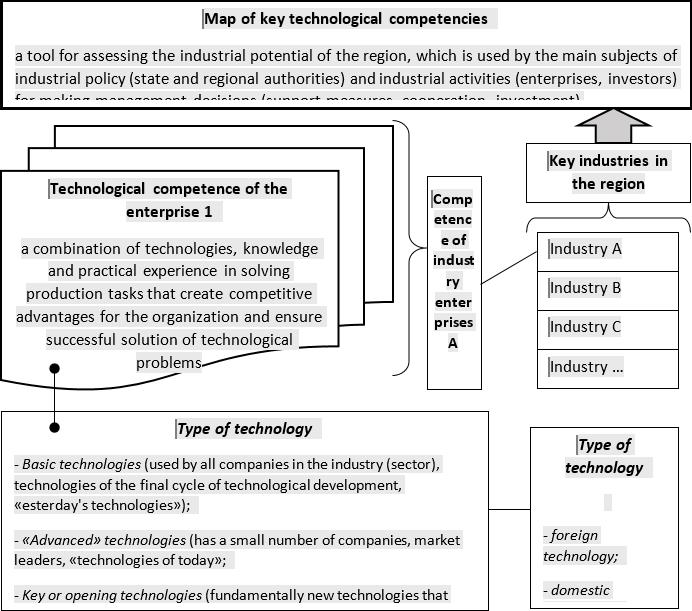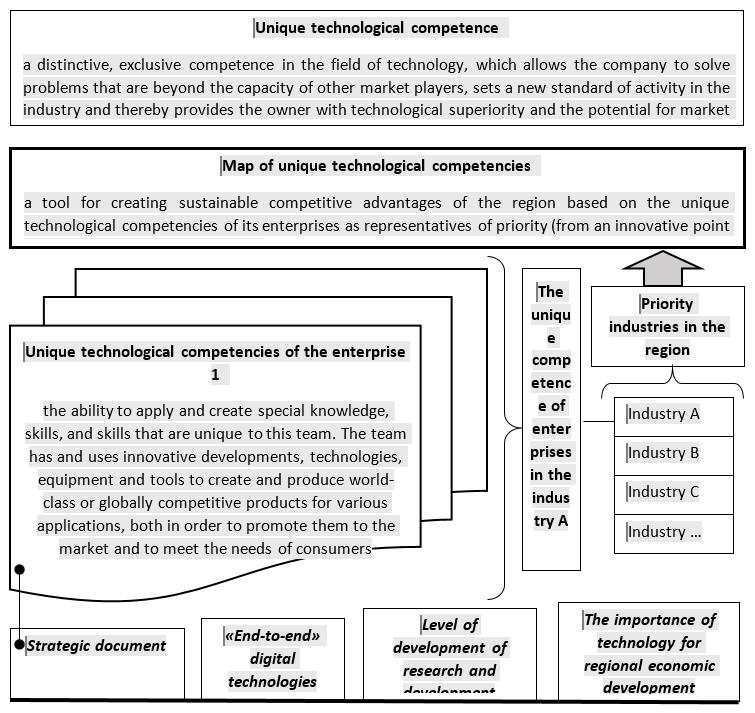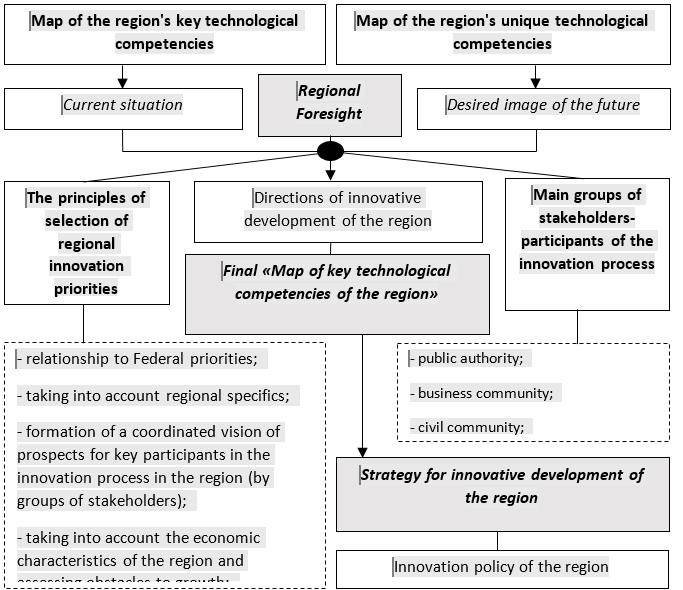Abstract
The dynamic external environment defines three basic trends that accompany the process of digitalization of modern society and relate to the activities of each enterprise and individual: the active development of new technologies; individualization and dynamism of human behavior; and the globalization of supply and demand. These trends should be studied through the prism of the formation of competitive advantages of the region as a socio-economic system. They are defined by innovative technologies and key competencies. It is worth paying attention to the problem of creating an «early warning» mechanism for timely identification of opportunities and threats in terms of the emergence and use of new technologies and new needs. According to the authors, the competence approach and the concept of technology assessment can become an effective tool for studying the issues of innovative development of the region, as well as increasing the level of participation and role of society in the decision-making process. The key competencies of the region should be unique and can serve as a basic basis for choosing strategic priorities, according to the concept of «smart specialization». Therefore, the purpose of the study is to form a methodological approach to building a map of key technological competencies as a visual tool for developing a strategy for innovative development of the region. The proposed approach makes it possible to provide the process of «entrepreneurial search» with a new information and analytical resource for more effective interaction of regional stakeholders in the foresight session mode.
Keywords: Innovative development of the region, key technological competencies, «smart specialization», four-link innovation spiral
Introduction
According to the concept of «smart specialization», the development of the region is determined by the choice of priorities based on industry specialization and supported by distinctive «comparative» competitive advantages (Kutsenko et al., 2018). Moreover, such advantages can be transferred to the key competencies of the region, which are the result of «collective training» of stakeholders in the regional innovation process. Applying the competences approach to the study of innovation development of the region, define what core competence of the region is the quality characteristics of the region, which determine its distinctive advantages; a set of knowledge, abilities and skills that allow the region to provide consumers with a variety of target segments is a fundamental benefit; the combination of unique extra abilities, developing in the region (Hamel & Prahalad, 2014). Within the framework of this study, the priority is the technological component of the competence model, which is key in the concept of «smart specialization», which takes into account the unique features of the territory in the formation of the strategy of innovative development, taking into account scientific and technological progress. By key technological competencies, we mean the ability and capabilities to implement the unique «comparative» competitive advantages of the regional economic system, which consists of four main groups of stakeholders (according to the model of the four-link innovation spiral), providing the process of «entrepreneurial search» based on the principles of the concept of «smart specialization» (Carayannis & Grigoroudis, 2016).
Problem Statement
For regions, the role of competencies is determined by the need to include in a complex structure not just enterprises with the required infrastructure and manufactured products, but business units with a certain level of competence. The optimal combination of the necessary competencies of various organizations as representatives of industry specializations in the region will provide a significant synergistic effect (Kuzmenko, 2017). The study of theoretical aspects and practical examples of technological development of enterprises in various sectors of the Russian economy allows us to conclude that at the moment there are significant problems in the formulation of their own technological competencies for domestic enterprises: most of them implement a «product» approach; there is no method of multi-variant formulation of competencies (Bakhtina, 2017). The same can be said for the regions. In the course of the study, we encountered a lack of well-developed algorithms for the formation of key competencies in the region, although the importance of this process is described very well. Therefore, the relevance of this research topic is related to the need to develop tools for the formation and development of key technological competencies in the region, in accordance with the principles of the concept of «smart specialization».
Research Questions
Within the framework of this research, it is necessary to study theoretical issues and methodological aspects of the formation of key competencies of the region as a socio-economic system.
3.1. Based on the model of the four-link innovation spiral, the author considers the possibility of using the competence approach in choosing the priorities of innovative development of the region through the map of key technological competencies of the region.
3.2. Based on the existing scientific background, the author proposes a methodological approach to designing a map of key technological competencies of the region as a new information format for conducting regional foresight.
Purpose of the Study
The purpose of this research is to study theoretical and methodological approaches to the concept of key competencies of the region as a modern scientific theory about the competitive advantages of socio-economic systems, which allows forming the trajectory of innovative development in the long term, taking into account the requirements of «smart specialization».
Research Methods
To achieve this goal, in the course of preparing this article, we used modern theoretical material and methodological scientific background that allows us to study the problems of innovative development of the region from the position of its key competencies, scientific works of domestic and foreign scientists on research issues. General scientific and special methods of scientific search were used in the research process: system analysis, comparison, description, generalization, systematization.
Findings
Defining technological competencies is an important issue of innovative development of the region. The innovation process for any system level is primarily determined by information about needs and technologies. And needs are considered as a driver of socio-economic systems and the technologies to help in the following questions: what technologies can be used to meet customer needs most effectively, taking into account the evolution, replacement, and new technologies; found in other industries of similar problem solutions that you can use to create innovative products (Paap, 2020). It is the combination and interaction of the concepts of «needs» and «technologies», as well as their balance of interests that form the basis for building the necessary competence structure (model) of the region.
At the same time, the strategy of innovative development of the region should be based on the implementation of unique operations that form and use unique competencies as a response to the challenges of the external environment. In our opinion, to strengthen and complement the competence approach, it is necessary to use the tools and principles of the technology assessment concept to identify technological opportunities or «windows of opportunity» (Adner & Kapoor, 2017; Halicka, 2020). For the purposes of the study, based on the existing theoretical and methodological groundwork on this issue in the scientific literature, we highlight the following:
- technology forecasting (a basic tool for identifying the relationship between needs and technologies for their balance of interests; new needs are evaluated and predicted, as well as technologies needed to create new products that meet these needs);
- scenario approach (involves the development of several scenarios (for example, pessimistic, optimistic, realistic) based on the study of existing models of user behavior and / or technological development, describing several likely options with an assessment of the results and consequences);
- situational approach (allows you to form the most likely combinations of various changes through designing the image of the future, taking into account the influence of situational factors (external environment, needs, technologies, strategic orientation) and the alternative to achieving the same goal);
- user approach (defines needs and / or technologies through interaction with active customers who offer their own solution to meet the needs that are not typical for the target market segments and are not widely used);
- method of analogies (assessment of existing solutions in other areas (industries) suitable for solving the problem of research needs and / or technologies, since the existing accumulated experience and its adaptation to new environmental challenges are important);
- technology search (based on the postulate that innovation is not necessarily related to new technologies or needs, so the emphasis is on finding a new relationship between new technology and future (existing) need, as well as between existing technology and future (existing) need);
- matrix method (analysis of competition between ecosystems of old and new technologies and/or needs for forming the trajectory of further technological development, as well as the matrix format provides a visual representation of the priority of threats and opportunities in decision-making).
According to the concept of «smart specialization», the modern innovation policy of the region is formed as a result of «entrepreneurial search» in the format of a constructive dialogue between the stakeholders of the innovation spiral (state authorities, business community, civil society, science and education) (Carayannis & Grigoroudis, 2016). In both European and Russian practice, there is a need for modern tools that provide for the participation of stakeholders for the sound development of effective solutions for the implementation of regional innovation policy. Therefore, the «Map of key technological competencies» proposed by the authors is, on the one hand, a tool for studying the opportunities and directions of innovative development of the region in a technological format when choosing priorities for regional specialization. On the other hand, the general idea of the map is to create a balance of interests and plans for technological development of enterprises and regional and/or state programs and/or strategies, taking into account the point of view of the main groups of regional stakeholders in the innovation process. Figure 01 illustrates the proposed approach to creating a map of the region's key technological competencies.

This «basic» map of the region's key technological competencies, which captures the «here and now» picture, is the starting point for forming directions for further development of the region's specialization industries. To guide innovative development, the authors propose to consider the model of a «new» map of key technological competencies in the region, which focuses on the development of unique technological competencies. This «basic» map of the region's key technological competencies, which captures the «here and now» picture, is the starting point for forming directions for further development of the region's specialization industries. To guide innovative development, the authors propose to consider the model of a «new» map of key technological competencies in the region, which focuses on the development of unique technological competencies. Therefore, we will call it a map of the region's unique technological competencies. The approach to its formation is shown in Figure 02.
The first step in identifying unique technological competencies is to work with strategic documents to coordinate priorities at the federal, regional, and industry levels. These documents may include: the spatial development Strategy of the Russian Federation, the Strategy of scientific and technological development of the Russian Federation, the Strategy of innovative development of the Russian Federation, the digital development Program of the Russian Federation, Federal target programs, industry development Strategies, regional programs and projects, and others.
Further, the research focuses on «end-to-end» digital technologies and the possibilities of their use, according to the digital development Program of the Russian Federation: «big data; neurotechnologies and artificial intelligence; distributed registry systems; quantum technologies; new production technologies; industrial Internet; robotics and sensor components; wireless communication technologies; virtual and augmented reality technologies» (Digital Economy Of The Russian Federation Program, 2020). At this stage, it is necessary to determine the priority technologies for the region's industry specialization.

Thus, a unique technological competence is one of the components of the region's innovation competence as a criterion of its innovative receptivity. In this study, we will refer to the innovative competence of a region as everything that one region does better and that underlies the formation of a competitive advantage.
The compiled maps of the region's technological competencies that capture the current situation and the desired image of the future are the subject of discussion for regional foresight research. The foresight session will allow you to identify areas of innovative development in the region and form a final map of the region's key technological competencies in the format of a strategic guideline, as shown in Figure 03.

On the one hand, the final map of key technological competencies of the region provides an understanding of the possibility of forming and/or developing individual competencies that determine competitive behavior models within the framework of the innovation development strategy. On the other hand, such a map allows us to highlight aspects of interregional cooperation based on the similarity of the profile of technological competencies. At the same time, a model of cooperative behavior is being formed, aimed at finding technological opportunities and prospects for long-term cooperation with technology leaders at the regional and industry levels (Tronina et al., 2019). This fact is especially important for using the concept of «smart» specialization in Russian conditions.
Conclusion
Thus, the map of key technological competencies of the region helps stakeholders of the innovation process in the region to discuss the priorities of innovative development in the format of «entrepreneurial search», prescribed in the concept of «smart specialization». On the other hand, the map can be used as a basis for forming methodological recommendations for developing a strategy for innovative development of the region based on the principles of «smart specialization» in Russian conditions.
The directions for further research of the authors of the article are determined by such identified problems as motivation and involvement of the main groups of stakeholders (state authorities, business community, civil society, science and education) in the process of forming an innovative development strategy based on the balance of their interests in enhancing innovation activity and technological awareness. Also, of scientific interest are issues of development of interregional cooperation and partnership based on the analysis of competence profiles using the methodology of building a map of key technological competencies in the region.
Acknowledgments
This article was prepared in the framework of project 19-010-00144 on the theme «Management of innovative development of territories: the concept of «smart specialization» in Russian context», with the support of the Russian Foundation for Fundamental Research.
References
Adner, R., & Kapoor, R. (2017). An innovator's nightmare. Harvard Business Review Russia. https://hbr-russia.ru/
Bakhtina, S. S. (2017). Unique technological competencies as a key factor in ensuring the competitiveness of integrated structures in the global innovation economy. Enterprises, industries, and regions: Genesis, formation, development, and forecasting. Collection of scientific papers on the materials of the III International scientific and practical conference, 33-40.
Carayannis, E., & Grigoroudis, E. (2016). Quadruple Innovation Helix and Smart Specialization: Knowledge Production and National Competitiveness. Foresight and STI Governance, 10(1), 31-42. DOI:
Digital Economy Of The Russian Federation Program. (2020). https://digital.ac.gov.ru/
Halicka, K. (2020). Technology Selection Using the TOPSIS Method. Foresight and STI Governance, 14(1), 85-96. DOI:
Hamel, G., & Prahalad, K. (2014). Competing for the future. Creating the markets of tomorrow. Olymp-business.
Kutsenko, E., Islankina, E., & Kindras, A. (2018) Smart by Oneself? An Analysis of Russian Regional Innovation Strategies within the RIS3 Framework. Foresight and STI Governance, 12(1), 25-45. DOI:
Kuzmenko, N. (2017). Innovatsionnaya aktivnost' organizatsiy kak osnova formirovaniya innovatsionnoy ekonomiki v regionakh RF [Innovative activity of organizations as the basis for the formation of innovative economy in the regions of the Russian Federation]. Proceedings of the Voronezh State University of Engineering Technologies, 79(3), 286-293. DOI: 10.20914/2310-1202-2017-3-286-293 [in Russ.]
Paap, J. (2020). Mapping the Technological Landscape to Accelerate Innovation. Foresight and STI Governance, 14(3), 41-54. DOI:
Tronina, I., & Tatenko, G., & Bakhtina, S. (2019). Digital technologies in solving problems of innovative development of Russian regions. 1st International Scientific Conference "Modern Management Trends and the Digital Economy: from Regional Development to Global Economic Growth" (MTDE 2019). Advances in Economics and Management Research, 81, 253-261. DOI: 10.2991/mtde-19.2019.49
Copyright information

This work is licensed under a Creative Commons Attribution-NonCommercial-NoDerivatives 4.0 International License.
About this article
Publication Date
21 June 2021
Article Doi
eBook ISBN
978-1-80296-110-2
Publisher
European Publisher
Volume
111
Print ISBN (optional)
-
Edition Number
1st Edition
Pages
1-1168
Subjects
Social sciences, education and psychology, technology and education, economics and law, interdisciplinary sciences
Cite this article as:
Tronina, I. A., Tatenko, G. I., Knyazeva, V. A., Kupriyanov, A. N., & Bakhtina, S. S. (2021). Methodological Approach To Building A Map Of The Region Key Technological Competencies. In N. G. Bogachenko (Ed.), Amurcon 2020: International Scientific Conference, vol 111. European Proceedings of Social and Behavioural Sciences (pp. 1043-1050). European Publisher. https://doi.org/10.15405/epsbs.2021.06.03.138

